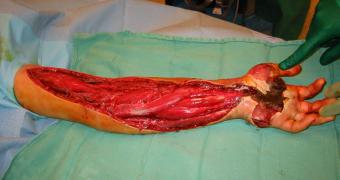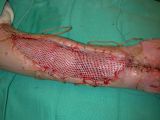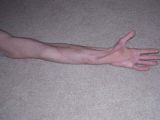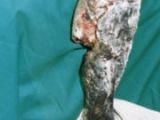Snakes and lizards are the sole groups of reptiles prospering after the extinction of the dinosaurs. But which is the secret of these legless lizards called snakes? Just one word: venom!
Snakes developed (or rather inherited from their lizard ancestors, related to monitor lizards and gila monsters) a terrific chemical weapon for attack and defense, with the minimum injury risk. Of the today's about 2,000 species of snakes, approximately 400 species can harm us with their venom (but not all of them can kill us).
The venom evolved initially in salivary glands and in many species, and it still has a digestive role, fact proved by the necrosis of the tissues at the bite site.
Only three groups of snakes are venomous: Elapids (cobras, kraits, coral snakes, mambas, true sea snakes and all Australian venomous snakes, like taipan and dead adder), Viperids (adders, vipers , rattlesnakes, pit vipers) and Colubrids, which compasses grass snakes, water snakes and related groups.
In the case of the Colubrids, even if the largest and most diverse snake group, not all the species are venomous and those who are have weak venom.
The Elapids have two fore teeth on the upper jaw transformed in immobile fangs. The Viperids (those rattlesnakes, too) have huge highly mobile fangs, which stay folded in repose and are risen only when the snake bites. Viperid's fangs do not possess a venom groove but a real closed venom duct, thus they inject venom, instead of pouring it into a wound.
Cobra type venomous snake tends to bite and keep a hold on, as many have shorter fangs and some coral snakes even chew. But the viperids, with their highly efficient injecting mechanism, bite sometimes in 1/40 of a second and then retreat.
Ultimately, the aggressiveness is important in appreciating the danger posed by a snake species, and most Elapids and Viperids are both aggressive and highly toxic.
Venoms are usually:
1. Neurotoxic, paralyzing the muscles. The victim dies of suffocation and heart attack. All cobra-related snakes have extremely potent neurotoxic venom, but also some rattlesnakes, moccasins and pitless vipers.
Death comes like in the case of curara: the victim dies while conscious.
2. Anaphylactic shock is produced by the cobra's venom. It is like hundreds of bees sting you.
3. Other venoms act like a powerful digesting juice, producing necrosis (tissue death) and hemorrhage.
Sea snake venom provokes elimination of mioglobin (muscle protein) through the kidney and necrosis into the muscles, but these snakes are not known to have ever bitten a person.
Most viperid (including rattlesnakes) have a powerful venom of this type and with their huge fangs can introduce large amounts of venom into the wounds.
The bushmaster (Lachesis muta), a pit viper from tropical America produces general necrosis, generalized internal hemorrhage and external hemorrhage through all the orifices. Indeed, the digestive venom of the bushmaster leaves the most horrible mutilated corpses of the snake victims. But rattlesnakes are nothing more than smaller bushmasters (or bushmasters are larger rattlesnakes).
This is the case of Justin Schwartz, 14, bitten by a Northern Pacific rattlesnake near Yosemite National Park, California. The 1.5 m (5 ft) long rattlesnake bit the boy in the middle of his left palm. The boy underwent fasciotomy: the doctors cut open his arm from the palm up to about the middle of the biceps, to remove the dead tissue. The boy's skin and neighboring tissues had been broken down to a "soup".
35 days and 8 surgeries cleaned out the dead tissue from his arm, and the doctors applied a skin graft from his leg to close up his arm, which had stayed open for 30 days after the fasciotomy until the skin graft surgery.
After 4 months of intense physical therapy, another surgery was performed to re-vascularize the arm: doctors took the blood vessels from a chunk of skin and muscles which through microsurgery where stitched to his arm. After 6 more months of physical therapy, the boy could move his fingers for 2-3 mm.
Now, five years after the bite, the boy's arm recovered fully mobility and 80% of the strength.
See the whole story of Justin at: http://www.rattlesnakebite.org/

 14 DAY TRIAL //
14 DAY TRIAL // 


